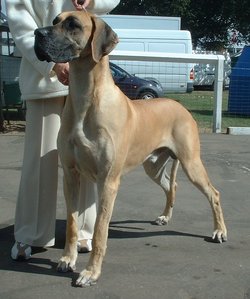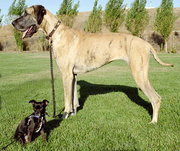Great Dane
|
|
| Great Dane | |||||||||||||||||||||
|---|---|---|---|---|---|---|---|---|---|---|---|---|---|---|---|---|---|---|---|---|---|
| Alternative names | |||||||||||||||||||||
| |||||||||||||||||||||
| Country of origin | |||||||||||||||||||||
| Germany | |||||||||||||||||||||
| Classification and breed standards | |||||||||||||||||||||
|
The Great Dane is a breed of dog known for its large size (giant) and gentle personality. The breed is commonly referred to as the "Gentle Giant".
| Contents |
Appearance
Great-Dane_wo_Background.jpg
There are six show-acceptable coat colors for Great Danes.
- Fawn: Light tan coat, possibly with a black mask.
- Brindle: Deep brown and black in a chevron stripe pattern. Often also referred to as a tiger-stripe pattern.
- Blue: Deep grey with a bluish tinge. Reminiscent of Weimaraners.
- Black: Pure jet black.
- Harlequin: Torn black patches on white. The Great Dane is the only dog breed that shows this particular coat color pattern. (Dalmatians have round black spots.)
- Mantle: Black coat and mask on white. Looks like the markings on Boston Terriers.
Other colors occur occasionally but are not acceptable in the show ring. Because they are not valid for show dogs, they are not pursued by breeders. These colors include white, fawnequin, merle, merlequin, fawn mantle, and others. These are sometimes advertised as "rare" colors to unsuspecting buyers. Any coat that includes "mouse grey" is disqualified from show.
Cropping of the ears is common in the United States and much less common in Europe.
Height and weight requirements for show dogs vary from one kennel club's standards to another, but generally the weight must fall between 100 to 120 lb (46 to 54 kg) and height must be between 28 and 32 inches (71 to 81 cm) at the withers.
Temperament
Typically they are smart, strong dogs who are protective and loyal to their owners. They take to training well and are fairly low maintenance compared to many other breeds.
Health
Great Danes, like most giant dogs, have a fairly slow metabolism. This results in less energy and less food consumption per pound of dog than in small breeds.
Great Danes have some health problems that are common to large breeds. Bloat (a painful distending and twisting of the stomach) is the primary cause of death in Great Danes. It is a commonly recommended practice for Great Danes to have their stomachs tacked (Gastropexy) to the interior rib lining during routine surgery such as spay/neuter. Another problem common to the breed is in the hips (hip dysplasia). Typically an x-ray of the parents can certify whether their hips are healthy and whether they are likely to have healthy pups.
Great Danes also suffer from several genetic disorders that are specific to the breed. For example, if a Great Dane lacks color (not white) near its eyes or ears then that organ does not develop and the dog will be either blind or deaf.
History
Often referred to as the "Apollo of Dogs", the Great Dane we know today is thought to be originally bred in Germany for hunting large wild boar.
Miscellaneous
Famous Danes
- Brad Anderson (cartoonist)'s newspaper comic character Marmaduke
- Hanna-Barbera's Scooby-Doo.
- Einstein in Oliver and Company
Dog Pictures and Clipart
- Pictures of Dogs (http://classroomclipart.com/cgi-bin/kids/imageFolio.cgi?direct=Animals/Dogs)
- Dog Clipart (http://classroomclipart.com/cgi-bin/kids/imageFolio.cgi?direct=Clipart/Animals/Dog_Clipart)
Clipart and Animal Pictures
- Clipart (https://classroomclipart.com/image/category/clipart.htm)
- Animal Clipart (https://classroomclipart.com/image/category/animal-clipart.htm)
- Animal Animated Clipart (https://classroomclipart.com/clipart/Animations/Animals.htm)
- Pictures of Animals (https://classroomclipart.com/image/category/animal-photos.htm)
- Amphibian Clip Art, Pictures and Photogaphs (https://classroomclipart.com/image/category/amphibian-clipart.htm)
- Farm Animal Clip Art, Pictures and Photographs (https://classroomclipart.com/image/category/farm-animal-clipart.htm)
- Mammal Clip Art, Pictures and Photographs (https://classroomclipart.com/image/category/mammal-clipart.htm)
- Marine Animal Clip Art, Pictures and Photographs (https://classroomclipart.com/image/category/marine-life-clipart.htm)
- Reptile Clip Art, Pictures and Photographs (https://classroomclipart.com/image/category/reptile-clipart.htm)
- Spider Clip Art, Pictures and Photographs (https://classroomclipart.com/image/category/spider-clipart.htm)





